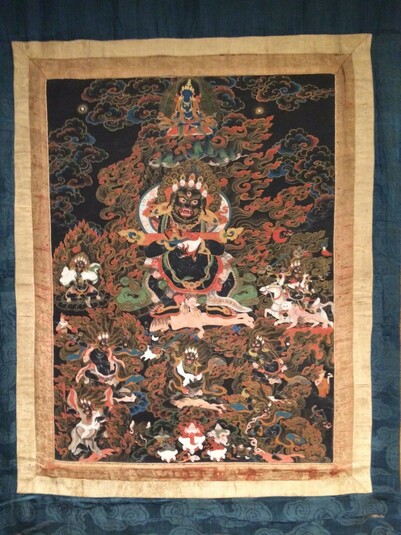
Item: Mahakala (Buddhist Protector) - Panjarnata (Lord of the Pavilion)
| Origin Location | Tibet |
|---|---|
| Date Range | 1800 - 1899 |
| Lineages | Sakya, Ngor (Sakya) and Buddhist |
| Material | Black Background on Cotton |
| Collection | Private |
Panjarnata Mahakala (Tibetan: gur gyi gon po, English: the Great Black One, Lord of the Pavilion). (See the Panjarnata Mahakala Main Page).
With one face and two hands he holds a curved knife and skullcup to the heart with a 'gandhi' stick resting across the forearms. From this magical emanation stick all other forms of Mahakala are believed to emanate. His hair flames up like fire as he glares with large round eyes and a gaping mouth. Very fierce with all the customary wrathful ornaments and attire such as the necklace of fifty freshly severed heads, tiger skin lower garment and a long snake as a Brahmin cord, he also wears an ornate white scarf around the neck. In a slightly squat posture he stands atop a corpse above a dark sun disc surrounded by a mass of flaming fire of pristine awareness. Emanating above, from the circle of fire are three garudas. Often to the sides of Mahakala there typically would be wolves, black dogs, crows and a black man in front. These five types of beings, including the garudas above, are the messengers of Mahakala.
ཨེ་ཝམ་ཟིལ་གནོན་ཁང་ཚན་ལ། ཅི་བསྟོད་དགེ་རྒན་ཀུན་དགའ་རྒྱ་མཚོ་བས། གུར་མགོན་ལྕམ་དྲལ་ཞལ་ཐང་འདི་ཕུལ་བས། སངས་རྒྱས་བསྟན་པ་དང་རྣལ་འབྱོར་པ་ཅག་ལ། ངན་སེམས་ལོག་ལྟ་ཅན་རྣམས་ཚར་བཅད་ནས། ཕྱི་ནང་བར་ཆད་མྱུར་དུ་ཞི་བར་མཛོད།
Inscription on back: "This painting of Panjara and retinue is offered by the teacher Kunga Gyatso to the monastic house Ewam Zilnon [with the wish] to completely eliminate the wrong views concerning the Buddha's teachings and yogis and to swiftly pacify all outer and inner obstacles."
At the top of the composition is Buddha Vajradhara, blue in colour, wearing the ornaments and garb of a peaceful deity. He holds a vajra and bell crossed at the heart in the 'vajra embracing' gesture (mudra).
At the middle left side is Ekajati holding a vase in the upraised two hands. On the right side is Shri Devi Dudsolma with four arms and riding a donkey.
In the lower portion of the composition are the Five Karma Activity deities: Kala Rakshasa, Kal Rakshasi, Putra, Bhatra and Singmo. These five as a group are the special activity servants for Panjarnata. In addition there are four other small figures depicted in the lower composition. At the far left is a warrior. At the bottom left there is a black woman. At the bottom right there is a mantradharin (ngagpa). At the lower right side there is a Buddhist monk (bhikshu). These four figures of the outer retinue each represent a thousand figures for each of the four types: a 1000 warriors, a 1000 black women, a 1000 mantradharins, and a 1000 bhikshus.
Panjaranata Mahakala is the protector for the Hevajra cycle of Tantras. The iconography and rituals are found in the 18th chapter of the Vajra Panjara Tantra (canopy, or pavilion), an exclusive 'explanatory tantra' to the Hevajra Tantra itself. Forms of the two armed Mahakala can also be found in the Twenty-five and Fifty Chapter Mahakala Tantras.
Lineage: Vajradhara, Vajrapanjara Dakini, Brahmin Vararuchi, Pandita Deva Vajra, Shraddha Karavarma, Lochen Rinchen Zangpo, Drag Tengpa Yontan Tsultrim, Mal Lotsawa Lodro Drag, Sachen Kunga Nyingpo (1092-1158), etc.
Black ground paintings, taught in the Twenty-five and Fifty Chapter Mahakala Tantras, were originally specific to Mahakala and Shri Devi. The cloth was obtained as rags from charnel grounds and the black colouring was produced from charnel ground ashes and charcoal. Over time the style of black ground was also employed for other protector deities and some meditational forms such as Hevajra, Chakrasamvara and Vajrabhairava. In the 20th century, modern painters have even depicted peaceful deities on a black ground contrary to the original intention and meaning.
Jeff Watt 12-2013
Reverse of Painting
English Translation of Inscription: This painting of Panjara and retinue is offered by the teacher Kunga Gyatso to the monastic house Ewam Zilnon [with the wish] to completely eliminate the wrong views of those practitioners of the Buddha's teachings and to swiftly pacify all of the outer and inner obstacles.
Special Features: (Cursive script (Umay))
Mahakala: Panjarnata, Lord of the Pavilion (Main Page)
Collection: Private 32



